NSB202: Addressing Racism for Cultural Safety & Indigenous Well-being
VerifiedAdded on 2023/04/23
|11
|3180
|173
Essay
AI Summary
This essay explores the critical concept of cultural safety in the context of healthcare for Aboriginal and Torres Strait Islander peoples in Australia. It addresses the pervasive issues of personal and systemic racism, highlighting how these factors contribute to health inequalities and hinder access to quality care. The essay delves into the power dynamics associated with 'whiteness' and their implications for nursing practice, contrasting cultural safety with cultural competency. Through the lens of the 5Rs of Reflection (Reporting, Responding, Relating, Reasoning, and Reconstructing), the author reflects on healthcare inequalities and the role of nurses in bridging the gap. Furthermore, the essay examines how institutional racism manifests in access to health, education, and employment, emphasizing the urgent need for culturally safe nursing practices to address these disparities and promote equitable healthcare outcomes for Indigenous Australians. The paper concludes by reflecting on the roles of nurses in providing healthcare services in Australia using the 5Rs framework, ultimately advocating for a healthcare system free of racism and inequality, where all Aboriginal and Torres Strait Islander peoples have access to effective, high-quality, appropriate, and affordable care.
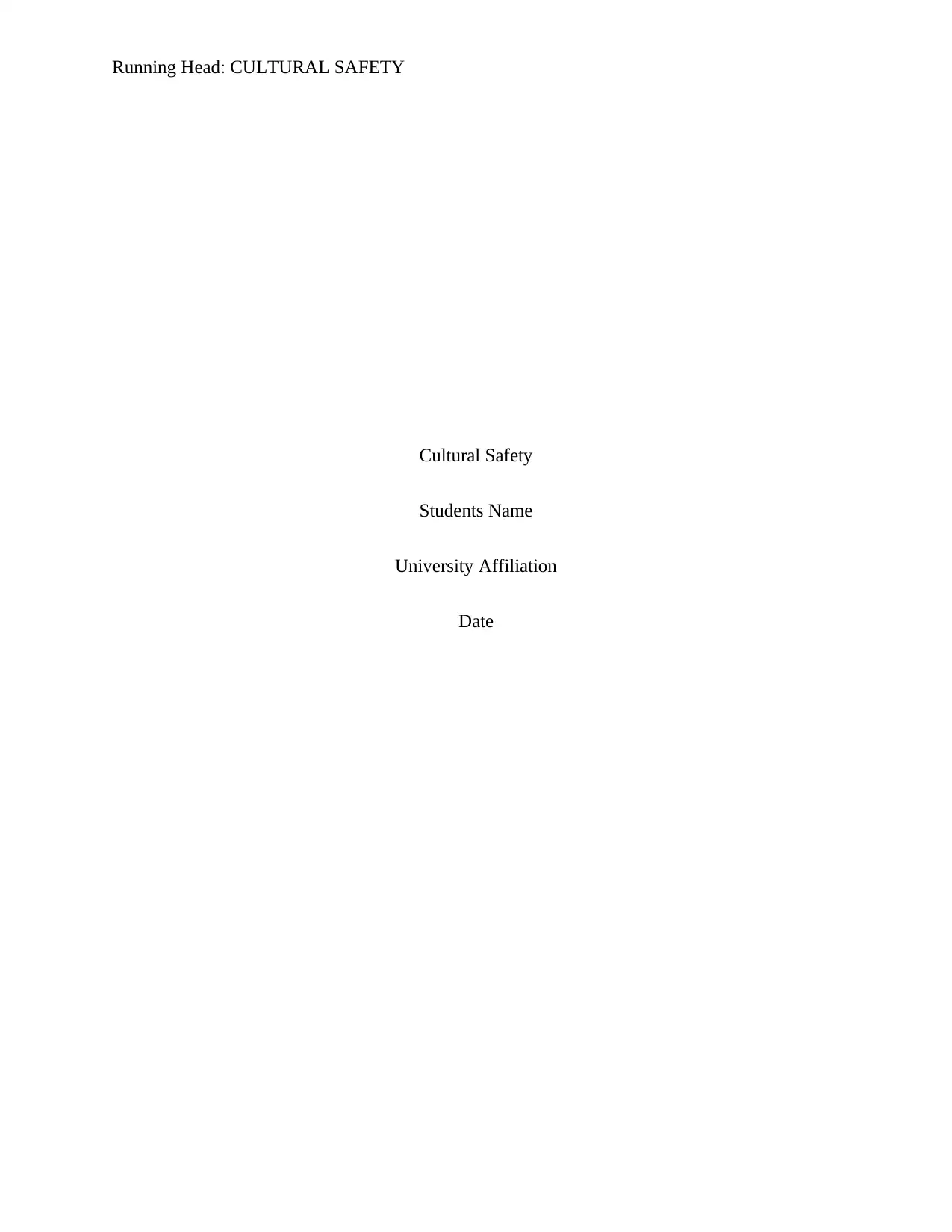
Running Head: CULTURAL SAFETY
Cultural Safety
Students Name
University Affiliation
Date
Cultural Safety
Students Name
University Affiliation
Date
Paraphrase This Document
Need a fresh take? Get an instant paraphrase of this document with our AI Paraphraser
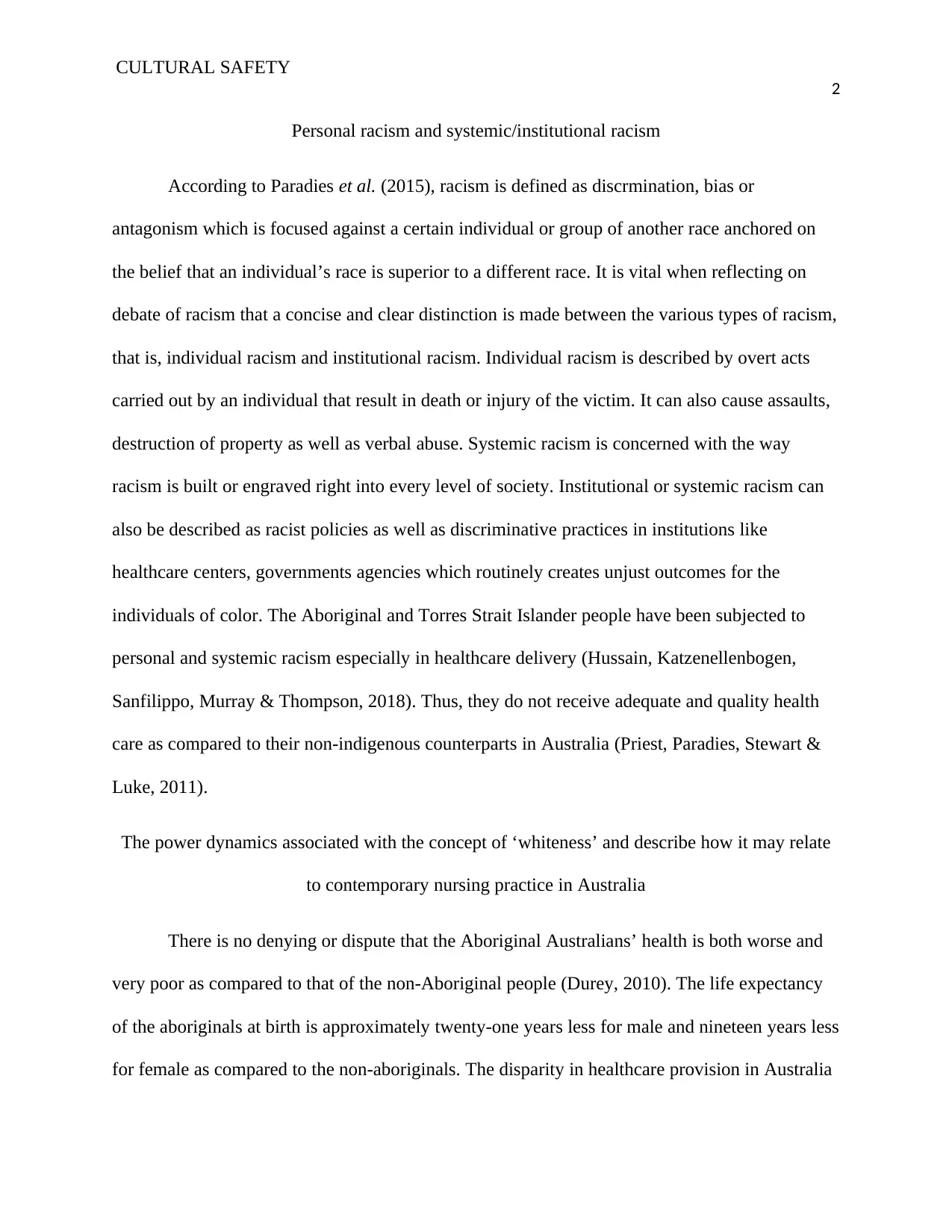
CULTURAL SAFETY
2
Personal racism and systemic/institutional racism
According to Paradies et al. (2015), racism is defined as discrmination, bias or
antagonism which is focused against a certain individual or group of another race anchored on
the belief that an individual’s race is superior to a different race. It is vital when reflecting on
debate of racism that a concise and clear distinction is made between the various types of racism,
that is, individual racism and institutional racism. Individual racism is described by overt acts
carried out by an individual that result in death or injury of the victim. It can also cause assaults,
destruction of property as well as verbal abuse. Systemic racism is concerned with the way
racism is built or engraved right into every level of society. Institutional or systemic racism can
also be described as racist policies as well as discriminative practices in institutions like
healthcare centers, governments agencies which routinely creates unjust outcomes for the
individuals of color. The Aboriginal and Torres Strait Islander people have been subjected to
personal and systemic racism especially in healthcare delivery (Hussain, Katzenellenbogen,
Sanfilippo, Murray & Thompson, 2018). Thus, they do not receive adequate and quality health
care as compared to their non-indigenous counterparts in Australia (Priest, Paradies, Stewart &
Luke, 2011).
The power dynamics associated with the concept of ‘whiteness’ and describe how it may relate
to contemporary nursing practice in Australia
There is no denying or dispute that the Aboriginal Australians’ health is both worse and
very poor as compared to that of the non-Aboriginal people (Durey, 2010). The life expectancy
of the aboriginals at birth is approximately twenty-one years less for male and nineteen years less
for female as compared to the non-aboriginals. The disparity in healthcare provision in Australia
2
Personal racism and systemic/institutional racism
According to Paradies et al. (2015), racism is defined as discrmination, bias or
antagonism which is focused against a certain individual or group of another race anchored on
the belief that an individual’s race is superior to a different race. It is vital when reflecting on
debate of racism that a concise and clear distinction is made between the various types of racism,
that is, individual racism and institutional racism. Individual racism is described by overt acts
carried out by an individual that result in death or injury of the victim. It can also cause assaults,
destruction of property as well as verbal abuse. Systemic racism is concerned with the way
racism is built or engraved right into every level of society. Institutional or systemic racism can
also be described as racist policies as well as discriminative practices in institutions like
healthcare centers, governments agencies which routinely creates unjust outcomes for the
individuals of color. The Aboriginal and Torres Strait Islander people have been subjected to
personal and systemic racism especially in healthcare delivery (Hussain, Katzenellenbogen,
Sanfilippo, Murray & Thompson, 2018). Thus, they do not receive adequate and quality health
care as compared to their non-indigenous counterparts in Australia (Priest, Paradies, Stewart &
Luke, 2011).
The power dynamics associated with the concept of ‘whiteness’ and describe how it may relate
to contemporary nursing practice in Australia
There is no denying or dispute that the Aboriginal Australians’ health is both worse and
very poor as compared to that of the non-Aboriginal people (Durey, 2010). The life expectancy
of the aboriginals at birth is approximately twenty-one years less for male and nineteen years less
for female as compared to the non-aboriginals. The disparity in healthcare provision in Australia
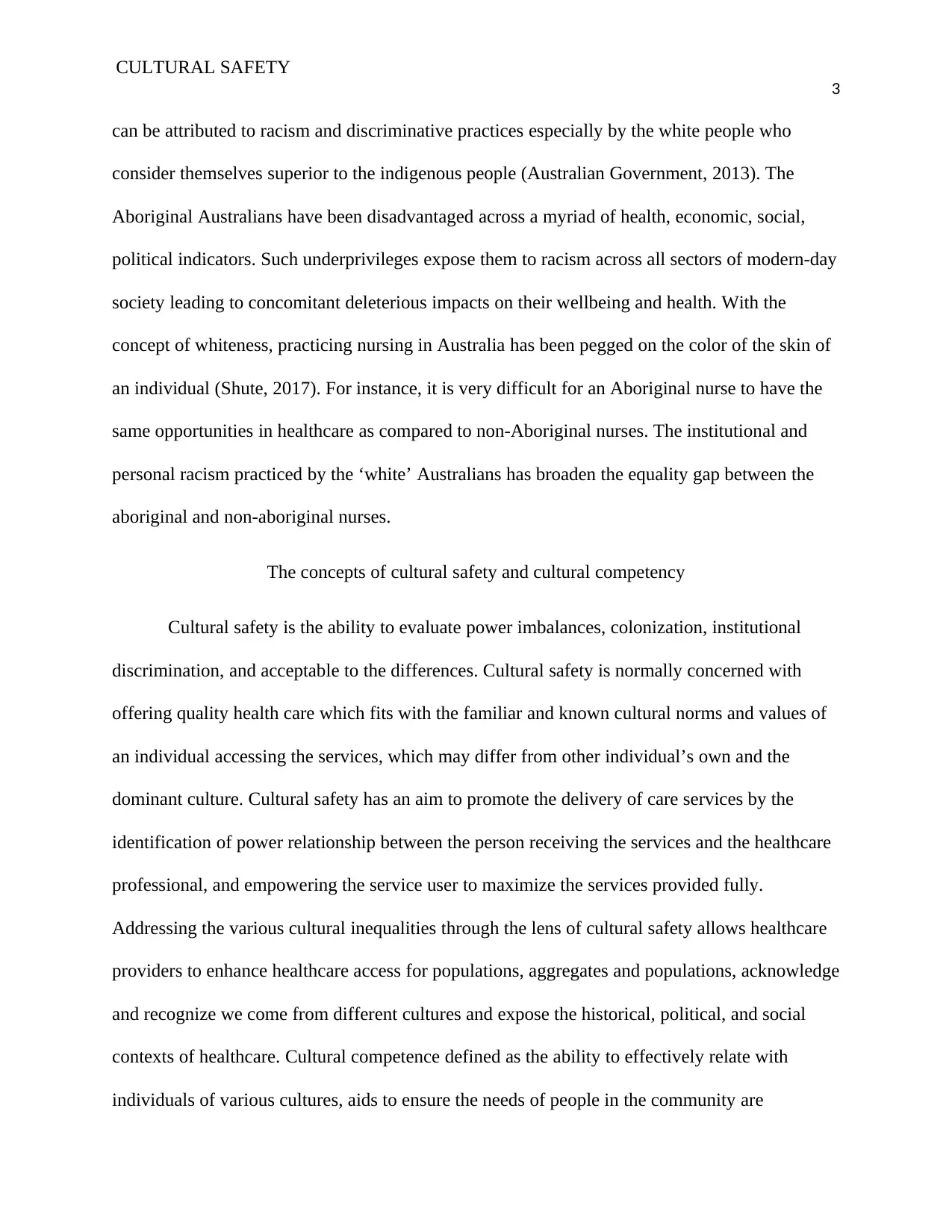
CULTURAL SAFETY
3
can be attributed to racism and discriminative practices especially by the white people who
consider themselves superior to the indigenous people (Australian Government, 2013). The
Aboriginal Australians have been disadvantaged across a myriad of health, economic, social,
political indicators. Such underprivileges expose them to racism across all sectors of modern-day
society leading to concomitant deleterious impacts on their wellbeing and health. With the
concept of whiteness, practicing nursing in Australia has been pegged on the color of the skin of
an individual (Shute, 2017). For instance, it is very difficult for an Aboriginal nurse to have the
same opportunities in healthcare as compared to non-Aboriginal nurses. The institutional and
personal racism practiced by the ‘white’ Australians has broaden the equality gap between the
aboriginal and non-aboriginal nurses.
The concepts of cultural safety and cultural competency
Cultural safety is the ability to evaluate power imbalances, colonization, institutional
discrimination, and acceptable to the differences. Cultural safety is normally concerned with
offering quality health care which fits with the familiar and known cultural norms and values of
an individual accessing the services, which may differ from other individual’s own and the
dominant culture. Cultural safety has an aim to promote the delivery of care services by the
identification of power relationship between the person receiving the services and the healthcare
professional, and empowering the service user to maximize the services provided fully.
Addressing the various cultural inequalities through the lens of cultural safety allows healthcare
providers to enhance healthcare access for populations, aggregates and populations, acknowledge
and recognize we come from different cultures and expose the historical, political, and social
contexts of healthcare. Cultural competence defined as the ability to effectively relate with
individuals of various cultures, aids to ensure the needs of people in the community are
3
can be attributed to racism and discriminative practices especially by the white people who
consider themselves superior to the indigenous people (Australian Government, 2013). The
Aboriginal Australians have been disadvantaged across a myriad of health, economic, social,
political indicators. Such underprivileges expose them to racism across all sectors of modern-day
society leading to concomitant deleterious impacts on their wellbeing and health. With the
concept of whiteness, practicing nursing in Australia has been pegged on the color of the skin of
an individual (Shute, 2017). For instance, it is very difficult for an Aboriginal nurse to have the
same opportunities in healthcare as compared to non-Aboriginal nurses. The institutional and
personal racism practiced by the ‘white’ Australians has broaden the equality gap between the
aboriginal and non-aboriginal nurses.
The concepts of cultural safety and cultural competency
Cultural safety is the ability to evaluate power imbalances, colonization, institutional
discrimination, and acceptable to the differences. Cultural safety is normally concerned with
offering quality health care which fits with the familiar and known cultural norms and values of
an individual accessing the services, which may differ from other individual’s own and the
dominant culture. Cultural safety has an aim to promote the delivery of care services by the
identification of power relationship between the person receiving the services and the healthcare
professional, and empowering the service user to maximize the services provided fully.
Addressing the various cultural inequalities through the lens of cultural safety allows healthcare
providers to enhance healthcare access for populations, aggregates and populations, acknowledge
and recognize we come from different cultures and expose the historical, political, and social
contexts of healthcare. Cultural competence defined as the ability to effectively relate with
individuals of various cultures, aids to ensure the needs of people in the community are
⊘ This is a preview!⊘
Do you want full access?
Subscribe today to unlock all pages.

Trusted by 1+ million students worldwide
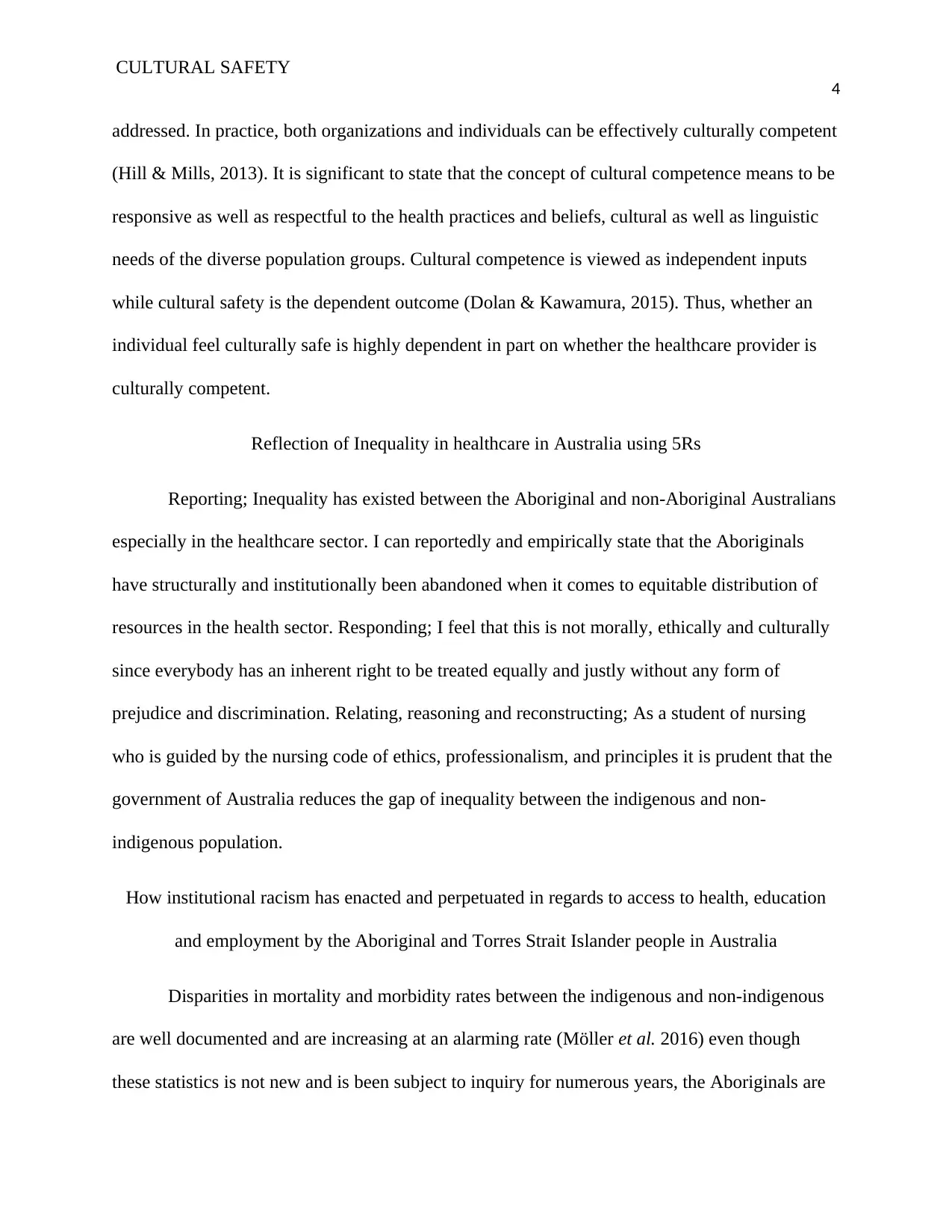
CULTURAL SAFETY
4
addressed. In practice, both organizations and individuals can be effectively culturally competent
(Hill & Mills, 2013). It is significant to state that the concept of cultural competence means to be
responsive as well as respectful to the health practices and beliefs, cultural as well as linguistic
needs of the diverse population groups. Cultural competence is viewed as independent inputs
while cultural safety is the dependent outcome (Dolan & Kawamura, 2015). Thus, whether an
individual feel culturally safe is highly dependent in part on whether the healthcare provider is
culturally competent.
Reflection of Inequality in healthcare in Australia using 5Rs
Reporting; Inequality has existed between the Aboriginal and non-Aboriginal Australians
especially in the healthcare sector. I can reportedly and empirically state that the Aboriginals
have structurally and institutionally been abandoned when it comes to equitable distribution of
resources in the health sector. Responding; I feel that this is not morally, ethically and culturally
since everybody has an inherent right to be treated equally and justly without any form of
prejudice and discrimination. Relating, reasoning and reconstructing; As a student of nursing
who is guided by the nursing code of ethics, professionalism, and principles it is prudent that the
government of Australia reduces the gap of inequality between the indigenous and non-
indigenous population.
How institutional racism has enacted and perpetuated in regards to access to health, education
and employment by the Aboriginal and Torres Strait Islander people in Australia
Disparities in mortality and morbidity rates between the indigenous and non-indigenous
are well documented and are increasing at an alarming rate (Möller et al. 2016) even though
these statistics is not new and is been subject to inquiry for numerous years, the Aboriginals are
4
addressed. In practice, both organizations and individuals can be effectively culturally competent
(Hill & Mills, 2013). It is significant to state that the concept of cultural competence means to be
responsive as well as respectful to the health practices and beliefs, cultural as well as linguistic
needs of the diverse population groups. Cultural competence is viewed as independent inputs
while cultural safety is the dependent outcome (Dolan & Kawamura, 2015). Thus, whether an
individual feel culturally safe is highly dependent in part on whether the healthcare provider is
culturally competent.
Reflection of Inequality in healthcare in Australia using 5Rs
Reporting; Inequality has existed between the Aboriginal and non-Aboriginal Australians
especially in the healthcare sector. I can reportedly and empirically state that the Aboriginals
have structurally and institutionally been abandoned when it comes to equitable distribution of
resources in the health sector. Responding; I feel that this is not morally, ethically and culturally
since everybody has an inherent right to be treated equally and justly without any form of
prejudice and discrimination. Relating, reasoning and reconstructing; As a student of nursing
who is guided by the nursing code of ethics, professionalism, and principles it is prudent that the
government of Australia reduces the gap of inequality between the indigenous and non-
indigenous population.
How institutional racism has enacted and perpetuated in regards to access to health, education
and employment by the Aboriginal and Torres Strait Islander people in Australia
Disparities in mortality and morbidity rates between the indigenous and non-indigenous
are well documented and are increasing at an alarming rate (Möller et al. 2016) even though
these statistics is not new and is been subject to inquiry for numerous years, the Aboriginals are
Paraphrase This Document
Need a fresh take? Get an instant paraphrase of this document with our AI Paraphraser
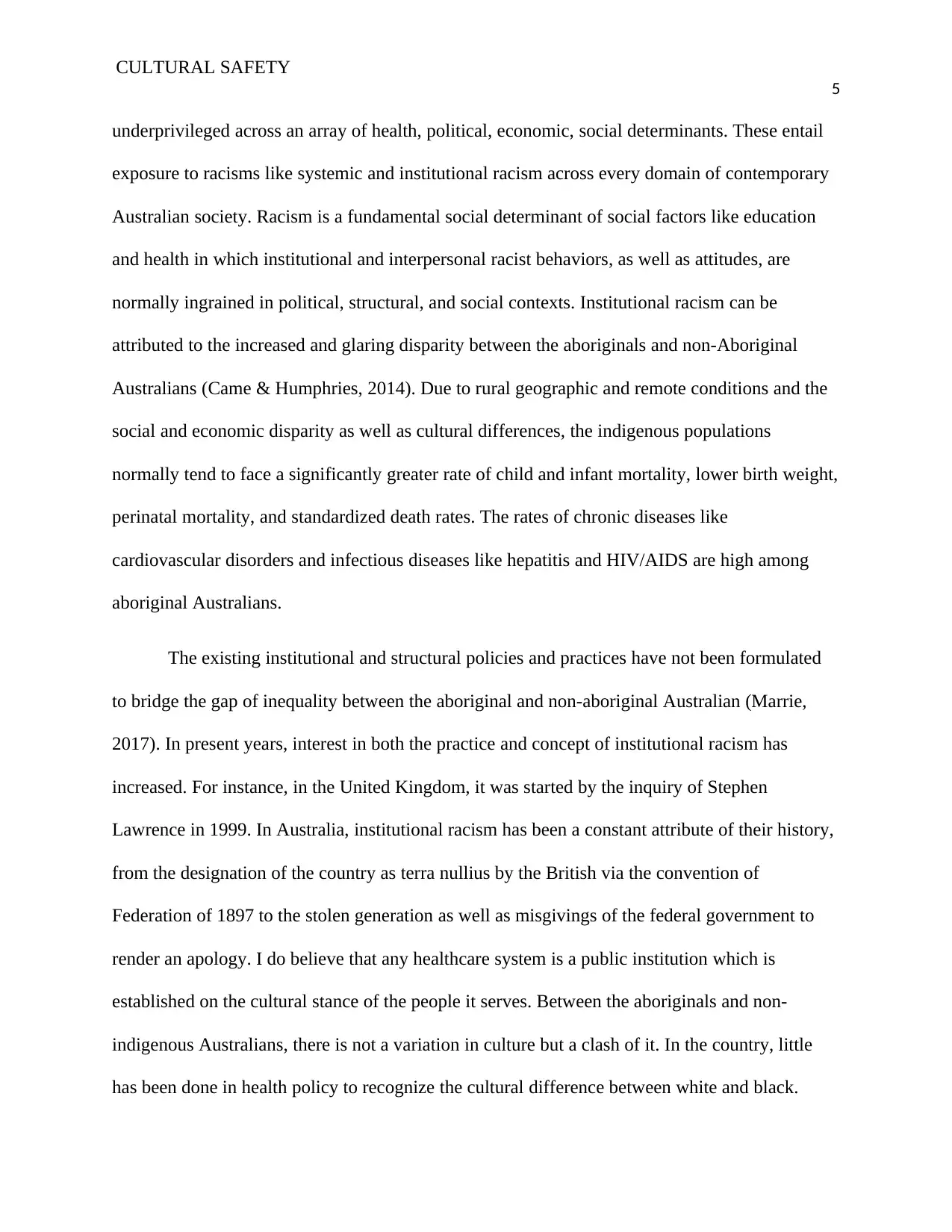
CULTURAL SAFETY
5
underprivileged across an array of health, political, economic, social determinants. These entail
exposure to racisms like systemic and institutional racism across every domain of contemporary
Australian society. Racism is a fundamental social determinant of social factors like education
and health in which institutional and interpersonal racist behaviors, as well as attitudes, are
normally ingrained in political, structural, and social contexts. Institutional racism can be
attributed to the increased and glaring disparity between the aboriginals and non-Aboriginal
Australians (Came & Humphries, 2014). Due to rural geographic and remote conditions and the
social and economic disparity as well as cultural differences, the indigenous populations
normally tend to face a significantly greater rate of child and infant mortality, lower birth weight,
perinatal mortality, and standardized death rates. The rates of chronic diseases like
cardiovascular disorders and infectious diseases like hepatitis and HIV/AIDS are high among
aboriginal Australians.
The existing institutional and structural policies and practices have not been formulated
to bridge the gap of inequality between the aboriginal and non-aboriginal Australian (Marrie,
2017). In present years, interest in both the practice and concept of institutional racism has
increased. For instance, in the United Kingdom, it was started by the inquiry of Stephen
Lawrence in 1999. In Australia, institutional racism has been a constant attribute of their history,
from the designation of the country as terra nullius by the British via the convention of
Federation of 1897 to the stolen generation as well as misgivings of the federal government to
render an apology. I do believe that any healthcare system is a public institution which is
established on the cultural stance of the people it serves. Between the aboriginals and non-
indigenous Australians, there is not a variation in culture but a clash of it. In the country, little
has been done in health policy to recognize the cultural difference between white and black.
5
underprivileged across an array of health, political, economic, social determinants. These entail
exposure to racisms like systemic and institutional racism across every domain of contemporary
Australian society. Racism is a fundamental social determinant of social factors like education
and health in which institutional and interpersonal racist behaviors, as well as attitudes, are
normally ingrained in political, structural, and social contexts. Institutional racism can be
attributed to the increased and glaring disparity between the aboriginals and non-Aboriginal
Australians (Came & Humphries, 2014). Due to rural geographic and remote conditions and the
social and economic disparity as well as cultural differences, the indigenous populations
normally tend to face a significantly greater rate of child and infant mortality, lower birth weight,
perinatal mortality, and standardized death rates. The rates of chronic diseases like
cardiovascular disorders and infectious diseases like hepatitis and HIV/AIDS are high among
aboriginal Australians.
The existing institutional and structural policies and practices have not been formulated
to bridge the gap of inequality between the aboriginal and non-aboriginal Australian (Marrie,
2017). In present years, interest in both the practice and concept of institutional racism has
increased. For instance, in the United Kingdom, it was started by the inquiry of Stephen
Lawrence in 1999. In Australia, institutional racism has been a constant attribute of their history,
from the designation of the country as terra nullius by the British via the convention of
Federation of 1897 to the stolen generation as well as misgivings of the federal government to
render an apology. I do believe that any healthcare system is a public institution which is
established on the cultural stance of the people it serves. Between the aboriginals and non-
indigenous Australians, there is not a variation in culture but a clash of it. In the country, little
has been done in health policy to recognize the cultural difference between white and black.
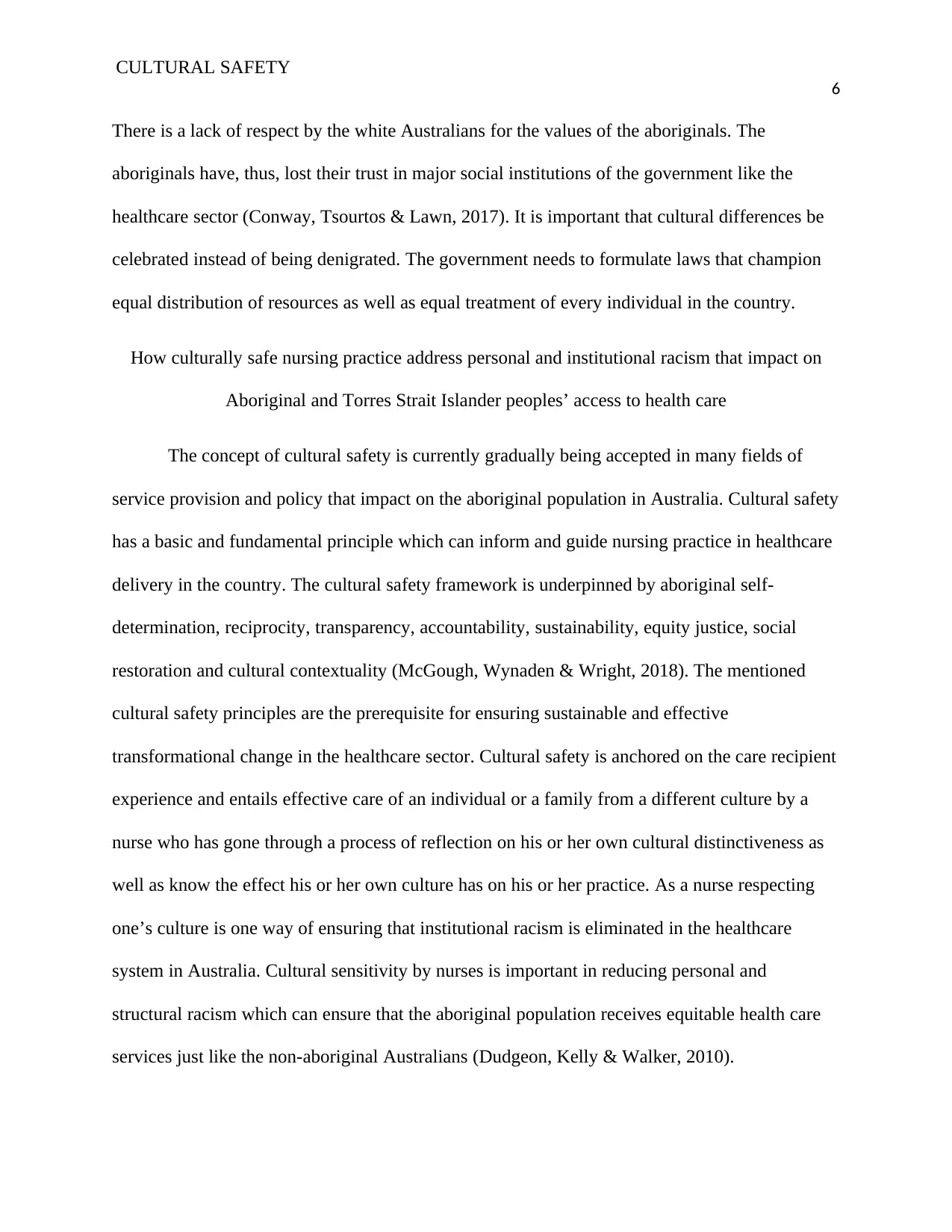
CULTURAL SAFETY
6
There is a lack of respect by the white Australians for the values of the aboriginals. The
aboriginals have, thus, lost their trust in major social institutions of the government like the
healthcare sector (Conway, Tsourtos & Lawn, 2017). It is important that cultural differences be
celebrated instead of being denigrated. The government needs to formulate laws that champion
equal distribution of resources as well as equal treatment of every individual in the country.
How culturally safe nursing practice address personal and institutional racism that impact on
Aboriginal and Torres Strait Islander peoples’ access to health care
The concept of cultural safety is currently gradually being accepted in many fields of
service provision and policy that impact on the aboriginal population in Australia. Cultural safety
has a basic and fundamental principle which can inform and guide nursing practice in healthcare
delivery in the country. The cultural safety framework is underpinned by aboriginal self-
determination, reciprocity, transparency, accountability, sustainability, equity justice, social
restoration and cultural contextuality (McGough, Wynaden & Wright, 2018). The mentioned
cultural safety principles are the prerequisite for ensuring sustainable and effective
transformational change in the healthcare sector. Cultural safety is anchored on the care recipient
experience and entails effective care of an individual or a family from a different culture by a
nurse who has gone through a process of reflection on his or her own cultural distinctiveness as
well as know the effect his or her own culture has on his or her practice. As a nurse respecting
one’s culture is one way of ensuring that institutional racism is eliminated in the healthcare
system in Australia. Cultural sensitivity by nurses is important in reducing personal and
structural racism which can ensure that the aboriginal population receives equitable health care
services just like the non-aboriginal Australians (Dudgeon, Kelly & Walker, 2010).
6
There is a lack of respect by the white Australians for the values of the aboriginals. The
aboriginals have, thus, lost their trust in major social institutions of the government like the
healthcare sector (Conway, Tsourtos & Lawn, 2017). It is important that cultural differences be
celebrated instead of being denigrated. The government needs to formulate laws that champion
equal distribution of resources as well as equal treatment of every individual in the country.
How culturally safe nursing practice address personal and institutional racism that impact on
Aboriginal and Torres Strait Islander peoples’ access to health care
The concept of cultural safety is currently gradually being accepted in many fields of
service provision and policy that impact on the aboriginal population in Australia. Cultural safety
has a basic and fundamental principle which can inform and guide nursing practice in healthcare
delivery in the country. The cultural safety framework is underpinned by aboriginal self-
determination, reciprocity, transparency, accountability, sustainability, equity justice, social
restoration and cultural contextuality (McGough, Wynaden & Wright, 2018). The mentioned
cultural safety principles are the prerequisite for ensuring sustainable and effective
transformational change in the healthcare sector. Cultural safety is anchored on the care recipient
experience and entails effective care of an individual or a family from a different culture by a
nurse who has gone through a process of reflection on his or her own cultural distinctiveness as
well as know the effect his or her own culture has on his or her practice. As a nurse respecting
one’s culture is one way of ensuring that institutional racism is eliminated in the healthcare
system in Australia. Cultural sensitivity by nurses is important in reducing personal and
structural racism which can ensure that the aboriginal population receives equitable health care
services just like the non-aboriginal Australians (Dudgeon, Kelly & Walker, 2010).
⊘ This is a preview!⊘
Do you want full access?
Subscribe today to unlock all pages.

Trusted by 1+ million students worldwide
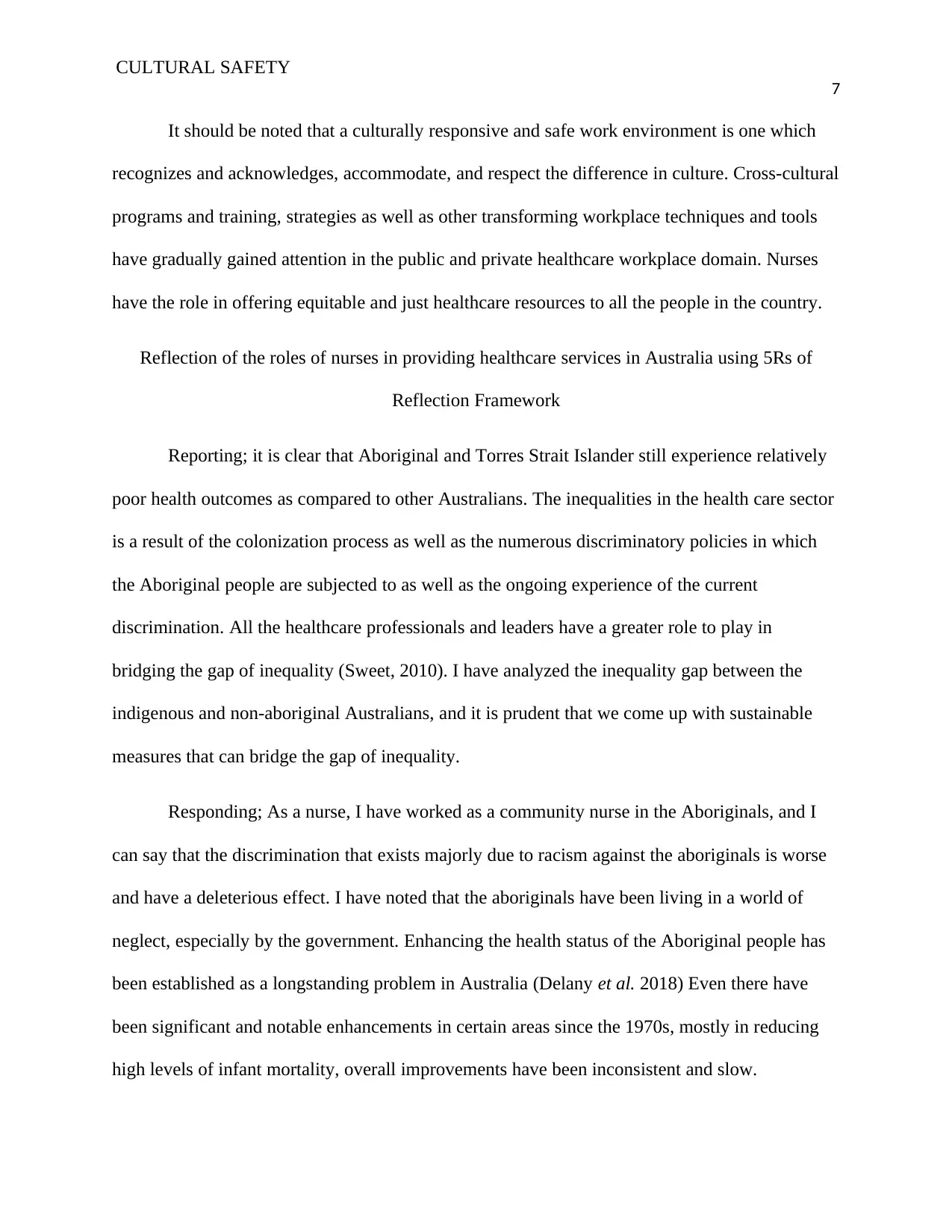
CULTURAL SAFETY
7
It should be noted that a culturally responsive and safe work environment is one which
recognizes and acknowledges, accommodate, and respect the difference in culture. Cross-cultural
programs and training, strategies as well as other transforming workplace techniques and tools
have gradually gained attention in the public and private healthcare workplace domain. Nurses
have the role in offering equitable and just healthcare resources to all the people in the country.
Reflection of the roles of nurses in providing healthcare services in Australia using 5Rs of
Reflection Framework
Reporting; it is clear that Aboriginal and Torres Strait Islander still experience relatively
poor health outcomes as compared to other Australians. The inequalities in the health care sector
is a result of the colonization process as well as the numerous discriminatory policies in which
the Aboriginal people are subjected to as well as the ongoing experience of the current
discrimination. All the healthcare professionals and leaders have a greater role to play in
bridging the gap of inequality (Sweet, 2010). I have analyzed the inequality gap between the
indigenous and non-aboriginal Australians, and it is prudent that we come up with sustainable
measures that can bridge the gap of inequality.
Responding; As a nurse, I have worked as a community nurse in the Aboriginals, and I
can say that the discrimination that exists majorly due to racism against the aboriginals is worse
and have a deleterious effect. I have noted that the aboriginals have been living in a world of
neglect, especially by the government. Enhancing the health status of the Aboriginal people has
been established as a longstanding problem in Australia (Delany et al. 2018) Even there have
been significant and notable enhancements in certain areas since the 1970s, mostly in reducing
high levels of infant mortality, overall improvements have been inconsistent and slow.
7
It should be noted that a culturally responsive and safe work environment is one which
recognizes and acknowledges, accommodate, and respect the difference in culture. Cross-cultural
programs and training, strategies as well as other transforming workplace techniques and tools
have gradually gained attention in the public and private healthcare workplace domain. Nurses
have the role in offering equitable and just healthcare resources to all the people in the country.
Reflection of the roles of nurses in providing healthcare services in Australia using 5Rs of
Reflection Framework
Reporting; it is clear that Aboriginal and Torres Strait Islander still experience relatively
poor health outcomes as compared to other Australians. The inequalities in the health care sector
is a result of the colonization process as well as the numerous discriminatory policies in which
the Aboriginal people are subjected to as well as the ongoing experience of the current
discrimination. All the healthcare professionals and leaders have a greater role to play in
bridging the gap of inequality (Sweet, 2010). I have analyzed the inequality gap between the
indigenous and non-aboriginal Australians, and it is prudent that we come up with sustainable
measures that can bridge the gap of inequality.
Responding; As a nurse, I have worked as a community nurse in the Aboriginals, and I
can say that the discrimination that exists majorly due to racism against the aboriginals is worse
and have a deleterious effect. I have noted that the aboriginals have been living in a world of
neglect, especially by the government. Enhancing the health status of the Aboriginal people has
been established as a longstanding problem in Australia (Delany et al. 2018) Even there have
been significant and notable enhancements in certain areas since the 1970s, mostly in reducing
high levels of infant mortality, overall improvements have been inconsistent and slow.
Paraphrase This Document
Need a fresh take? Get an instant paraphrase of this document with our AI Paraphraser
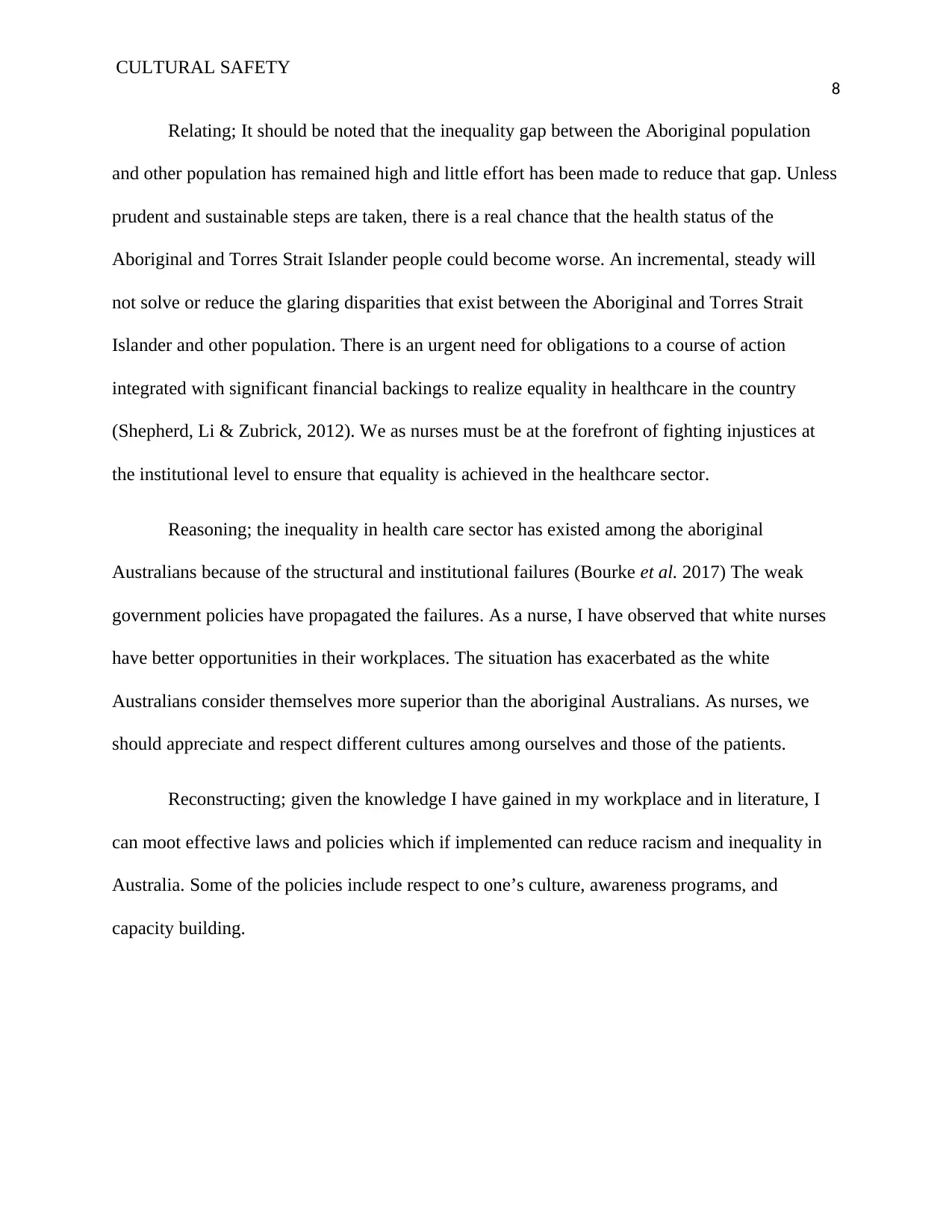
CULTURAL SAFETY
8
Relating; It should be noted that the inequality gap between the Aboriginal population
and other population has remained high and little effort has been made to reduce that gap. Unless
prudent and sustainable steps are taken, there is a real chance that the health status of the
Aboriginal and Torres Strait Islander people could become worse. An incremental, steady will
not solve or reduce the glaring disparities that exist between the Aboriginal and Torres Strait
Islander and other population. There is an urgent need for obligations to a course of action
integrated with significant financial backings to realize equality in healthcare in the country
(Shepherd, Li & Zubrick, 2012). We as nurses must be at the forefront of fighting injustices at
the institutional level to ensure that equality is achieved in the healthcare sector.
Reasoning; the inequality in health care sector has existed among the aboriginal
Australians because of the structural and institutional failures (Bourke et al. 2017) The weak
government policies have propagated the failures. As a nurse, I have observed that white nurses
have better opportunities in their workplaces. The situation has exacerbated as the white
Australians consider themselves more superior than the aboriginal Australians. As nurses, we
should appreciate and respect different cultures among ourselves and those of the patients.
Reconstructing; given the knowledge I have gained in my workplace and in literature, I
can moot effective laws and policies which if implemented can reduce racism and inequality in
Australia. Some of the policies include respect to one’s culture, awareness programs, and
capacity building.
8
Relating; It should be noted that the inequality gap between the Aboriginal population
and other population has remained high and little effort has been made to reduce that gap. Unless
prudent and sustainable steps are taken, there is a real chance that the health status of the
Aboriginal and Torres Strait Islander people could become worse. An incremental, steady will
not solve or reduce the glaring disparities that exist between the Aboriginal and Torres Strait
Islander and other population. There is an urgent need for obligations to a course of action
integrated with significant financial backings to realize equality in healthcare in the country
(Shepherd, Li & Zubrick, 2012). We as nurses must be at the forefront of fighting injustices at
the institutional level to ensure that equality is achieved in the healthcare sector.
Reasoning; the inequality in health care sector has existed among the aboriginal
Australians because of the structural and institutional failures (Bourke et al. 2017) The weak
government policies have propagated the failures. As a nurse, I have observed that white nurses
have better opportunities in their workplaces. The situation has exacerbated as the white
Australians consider themselves more superior than the aboriginal Australians. As nurses, we
should appreciate and respect different cultures among ourselves and those of the patients.
Reconstructing; given the knowledge I have gained in my workplace and in literature, I
can moot effective laws and policies which if implemented can reduce racism and inequality in
Australia. Some of the policies include respect to one’s culture, awareness programs, and
capacity building.
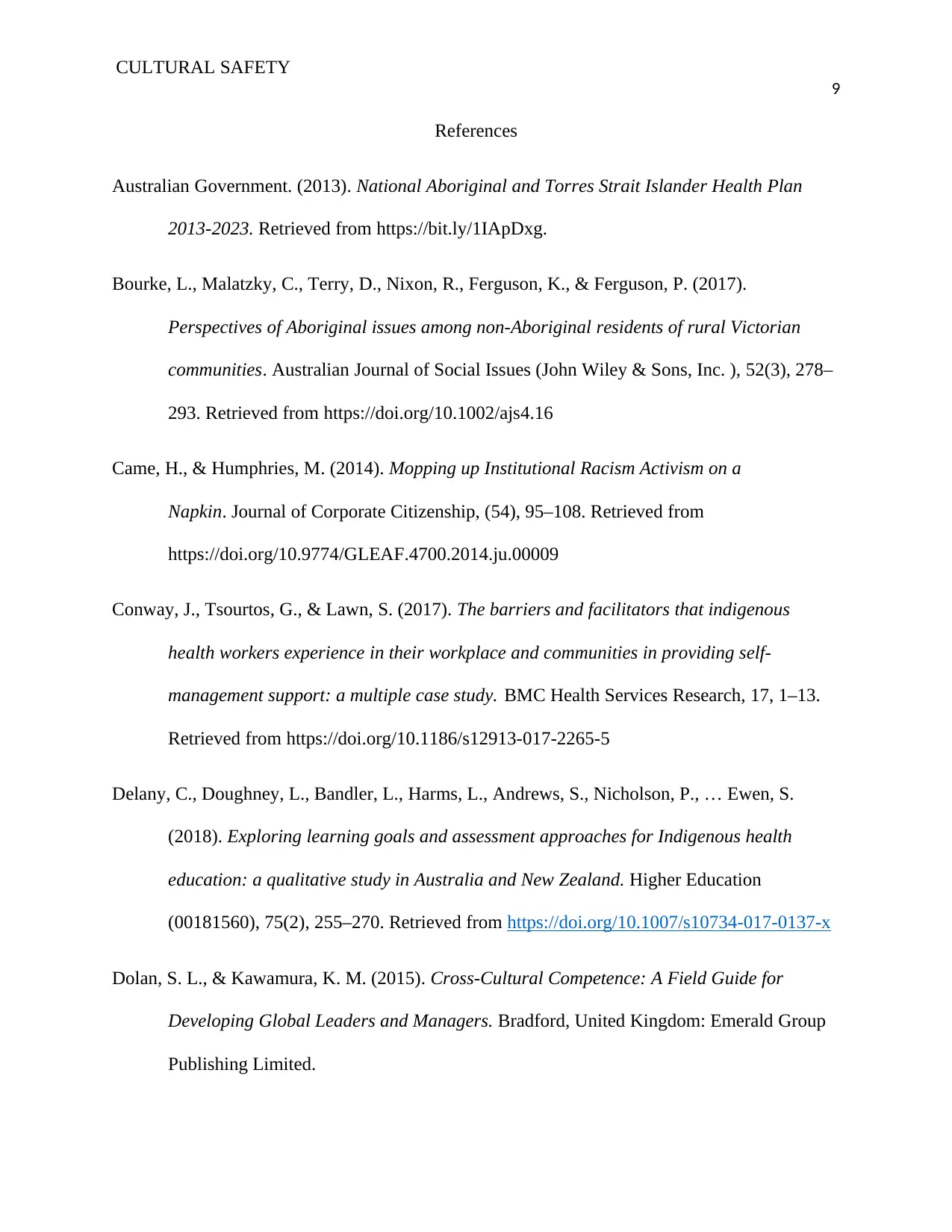
CULTURAL SAFETY
9
References
Australian Government. (2013). National Aboriginal and Torres Strait Islander Health Plan
2013-2023. Retrieved from https://bit.ly/1IApDxg.
Bourke, L., Malatzky, C., Terry, D., Nixon, R., Ferguson, K., & Ferguson, P. (2017).
Perspectives of Aboriginal issues among non-Aboriginal residents of rural Victorian
communities. Australian Journal of Social Issues (John Wiley & Sons, Inc. ), 52(3), 278–
293. Retrieved from https://doi.org/10.1002/ajs4.16
Came, H., & Humphries, M. (2014). Mopping up Institutional Racism Activism on a
Napkin. Journal of Corporate Citizenship, (54), 95–108. Retrieved from
https://doi.org/10.9774/GLEAF.4700.2014.ju.00009
Conway, J., Tsourtos, G., & Lawn, S. (2017). The barriers and facilitators that indigenous
health workers experience in their workplace and communities in providing self-
management support: a multiple case study. BMC Health Services Research, 17, 1–13.
Retrieved from https://doi.org/10.1186/s12913-017-2265-5
Delany, C., Doughney, L., Bandler, L., Harms, L., Andrews, S., Nicholson, P., … Ewen, S.
(2018). Exploring learning goals and assessment approaches for Indigenous health
education: a qualitative study in Australia and New Zealand. Higher Education
(00181560), 75(2), 255–270. Retrieved from https://doi.org/10.1007/s10734-017-0137-x
Dolan, S. L., & Kawamura, K. M. (2015). Cross-Cultural Competence: A Field Guide for
Developing Global Leaders and Managers. Bradford, United Kingdom: Emerald Group
Publishing Limited.
9
References
Australian Government. (2013). National Aboriginal and Torres Strait Islander Health Plan
2013-2023. Retrieved from https://bit.ly/1IApDxg.
Bourke, L., Malatzky, C., Terry, D., Nixon, R., Ferguson, K., & Ferguson, P. (2017).
Perspectives of Aboriginal issues among non-Aboriginal residents of rural Victorian
communities. Australian Journal of Social Issues (John Wiley & Sons, Inc. ), 52(3), 278–
293. Retrieved from https://doi.org/10.1002/ajs4.16
Came, H., & Humphries, M. (2014). Mopping up Institutional Racism Activism on a
Napkin. Journal of Corporate Citizenship, (54), 95–108. Retrieved from
https://doi.org/10.9774/GLEAF.4700.2014.ju.00009
Conway, J., Tsourtos, G., & Lawn, S. (2017). The barriers and facilitators that indigenous
health workers experience in their workplace and communities in providing self-
management support: a multiple case study. BMC Health Services Research, 17, 1–13.
Retrieved from https://doi.org/10.1186/s12913-017-2265-5
Delany, C., Doughney, L., Bandler, L., Harms, L., Andrews, S., Nicholson, P., … Ewen, S.
(2018). Exploring learning goals and assessment approaches for Indigenous health
education: a qualitative study in Australia and New Zealand. Higher Education
(00181560), 75(2), 255–270. Retrieved from https://doi.org/10.1007/s10734-017-0137-x
Dolan, S. L., & Kawamura, K. M. (2015). Cross-Cultural Competence: A Field Guide for
Developing Global Leaders and Managers. Bradford, United Kingdom: Emerald Group
Publishing Limited.
⊘ This is a preview!⊘
Do you want full access?
Subscribe today to unlock all pages.

Trusted by 1+ million students worldwide
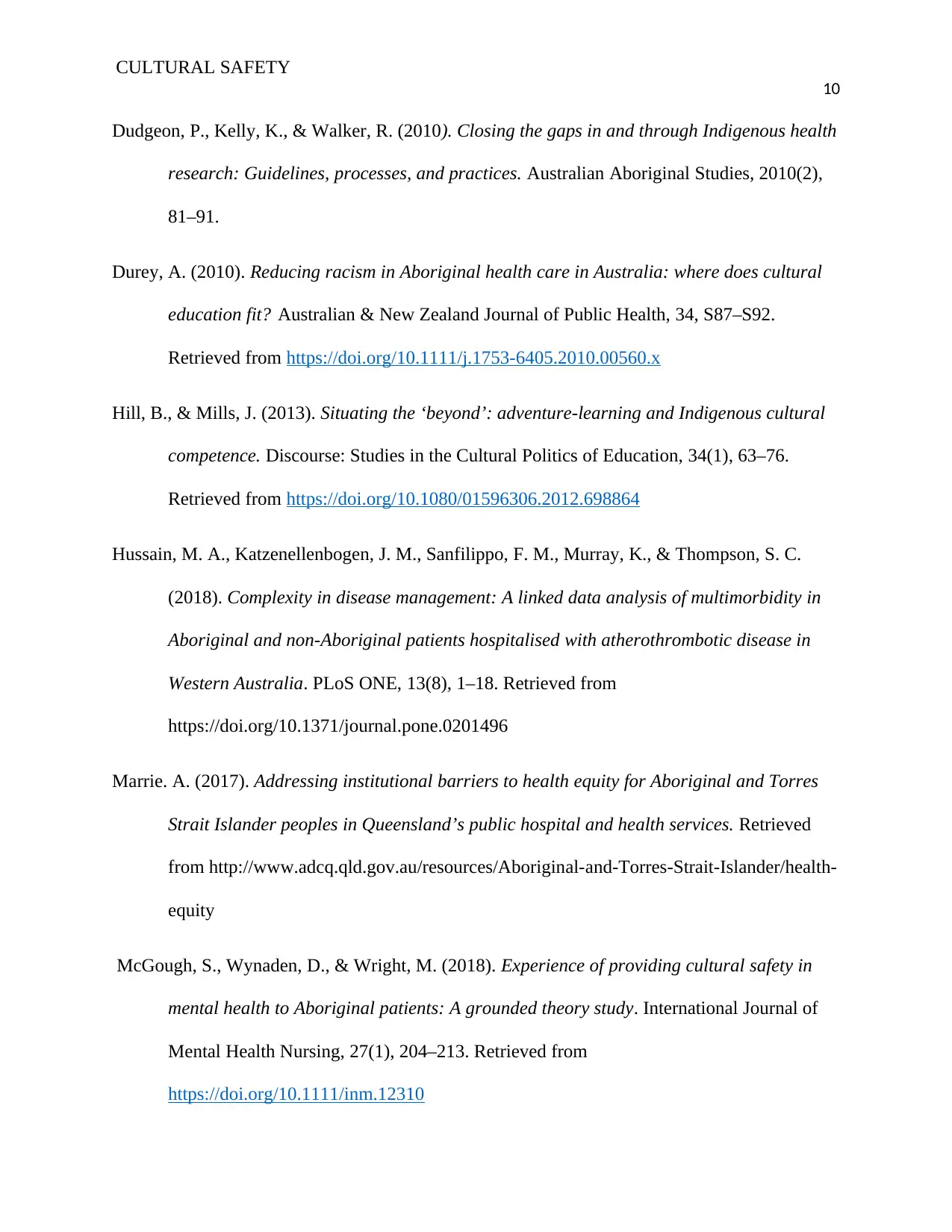
CULTURAL SAFETY
10
Dudgeon, P., Kelly, K., & Walker, R. (2010). Closing the gaps in and through Indigenous health
research: Guidelines, processes, and practices. Australian Aboriginal Studies, 2010(2),
81–91.
Durey, A. (2010). Reducing racism in Aboriginal health care in Australia: where does cultural
education fit? Australian & New Zealand Journal of Public Health, 34, S87–S92.
Retrieved from https://doi.org/10.1111/j.1753-6405.2010.00560.x
Hill, B., & Mills, J. (2013). Situating the ‘beyond’: adventure-learning and Indigenous cultural
competence. Discourse: Studies in the Cultural Politics of Education, 34(1), 63–76.
Retrieved from https://doi.org/10.1080/01596306.2012.698864
Hussain, M. A., Katzenellenbogen, J. M., Sanfilippo, F. M., Murray, K., & Thompson, S. C.
(2018). Complexity in disease management: A linked data analysis of multimorbidity in
Aboriginal and non-Aboriginal patients hospitalised with atherothrombotic disease in
Western Australia. PLoS ONE, 13(8), 1–18. Retrieved from
https://doi.org/10.1371/journal.pone.0201496
Marrie. A. (2017). Addressing institutional barriers to health equity for Aboriginal and Torres
Strait Islander peoples in Queensland’s public hospital and health services. Retrieved
from http://www.adcq.qld.gov.au/resources/Aboriginal-and-Torres-Strait-Islander/health-
equity
McGough, S., Wynaden, D., & Wright, M. (2018). Experience of providing cultural safety in
mental health to Aboriginal patients: A grounded theory study. International Journal of
Mental Health Nursing, 27(1), 204–213. Retrieved from
https://doi.org/10.1111/inm.12310
10
Dudgeon, P., Kelly, K., & Walker, R. (2010). Closing the gaps in and through Indigenous health
research: Guidelines, processes, and practices. Australian Aboriginal Studies, 2010(2),
81–91.
Durey, A. (2010). Reducing racism in Aboriginal health care in Australia: where does cultural
education fit? Australian & New Zealand Journal of Public Health, 34, S87–S92.
Retrieved from https://doi.org/10.1111/j.1753-6405.2010.00560.x
Hill, B., & Mills, J. (2013). Situating the ‘beyond’: adventure-learning and Indigenous cultural
competence. Discourse: Studies in the Cultural Politics of Education, 34(1), 63–76.
Retrieved from https://doi.org/10.1080/01596306.2012.698864
Hussain, M. A., Katzenellenbogen, J. M., Sanfilippo, F. M., Murray, K., & Thompson, S. C.
(2018). Complexity in disease management: A linked data analysis of multimorbidity in
Aboriginal and non-Aboriginal patients hospitalised with atherothrombotic disease in
Western Australia. PLoS ONE, 13(8), 1–18. Retrieved from
https://doi.org/10.1371/journal.pone.0201496
Marrie. A. (2017). Addressing institutional barriers to health equity for Aboriginal and Torres
Strait Islander peoples in Queensland’s public hospital and health services. Retrieved
from http://www.adcq.qld.gov.au/resources/Aboriginal-and-Torres-Strait-Islander/health-
equity
McGough, S., Wynaden, D., & Wright, M. (2018). Experience of providing cultural safety in
mental health to Aboriginal patients: A grounded theory study. International Journal of
Mental Health Nursing, 27(1), 204–213. Retrieved from
https://doi.org/10.1111/inm.12310
Paraphrase This Document
Need a fresh take? Get an instant paraphrase of this document with our AI Paraphraser
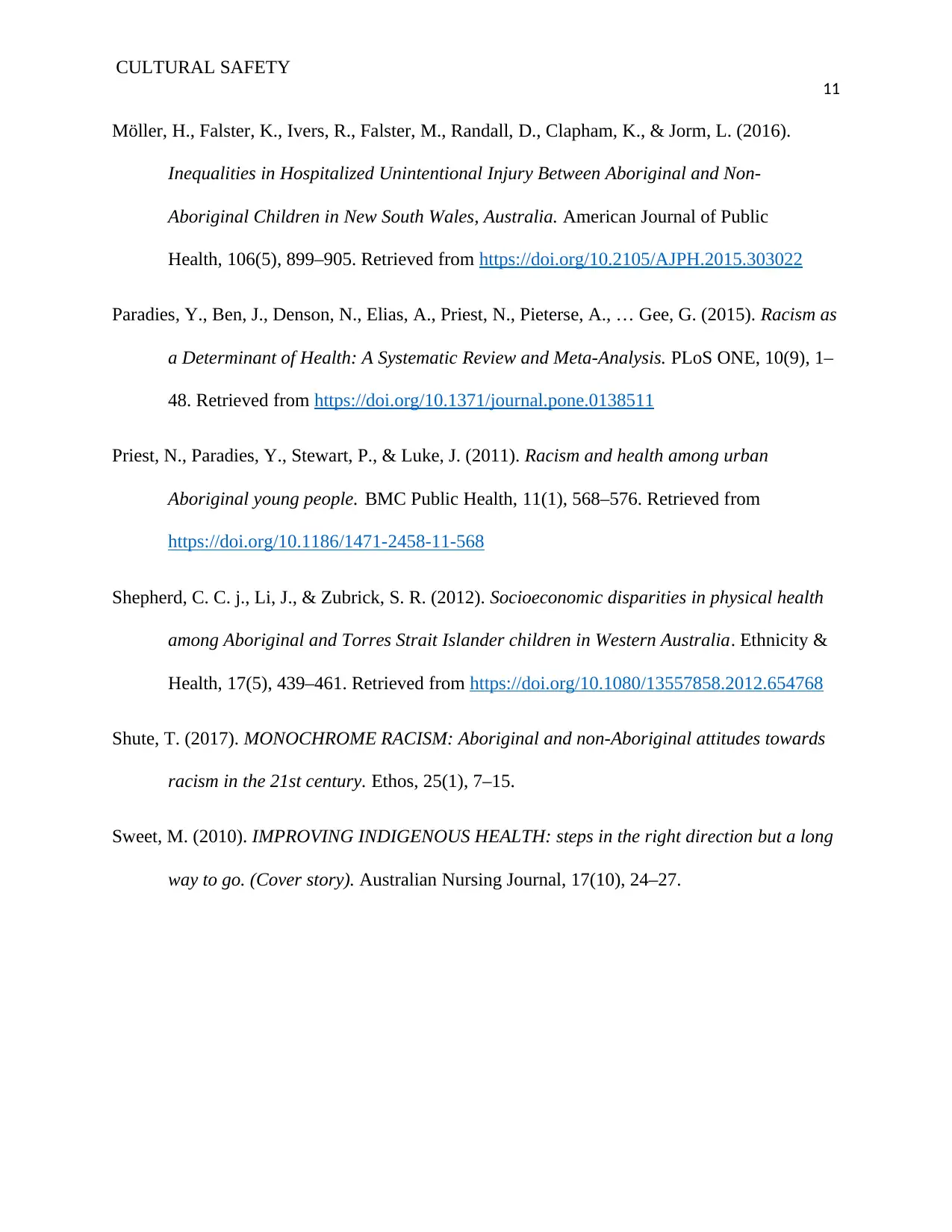
CULTURAL SAFETY
11
Möller, H., Falster, K., Ivers, R., Falster, M., Randall, D., Clapham, K., & Jorm, L. (2016).
Inequalities in Hospitalized Unintentional Injury Between Aboriginal and Non-
Aboriginal Children in New South Wales, Australia. American Journal of Public
Health, 106(5), 899–905. Retrieved from https://doi.org/10.2105/AJPH.2015.303022
Paradies, Y., Ben, J., Denson, N., Elias, A., Priest, N., Pieterse, A., … Gee, G. (2015). Racism as
a Determinant of Health: A Systematic Review and Meta-Analysis. PLoS ONE, 10(9), 1–
48. Retrieved from https://doi.org/10.1371/journal.pone.0138511
Priest, N., Paradies, Y., Stewart, P., & Luke, J. (2011). Racism and health among urban
Aboriginal young people. BMC Public Health, 11(1), 568–576. Retrieved from
https://doi.org/10.1186/1471-2458-11-568
Shepherd, C. C. j., Li, J., & Zubrick, S. R. (2012). Socioeconomic disparities in physical health
among Aboriginal and Torres Strait Islander children in Western Australia. Ethnicity &
Health, 17(5), 439–461. Retrieved from https://doi.org/10.1080/13557858.2012.654768
Shute, T. (2017). MONOCHROME RACISM: Aboriginal and non-Aboriginal attitudes towards
racism in the 21st century. Ethos, 25(1), 7–15.
Sweet, M. (2010). IMPROVING INDIGENOUS HEALTH: steps in the right direction but a long
way to go. (Cover story). Australian Nursing Journal, 17(10), 24–27.
11
Möller, H., Falster, K., Ivers, R., Falster, M., Randall, D., Clapham, K., & Jorm, L. (2016).
Inequalities in Hospitalized Unintentional Injury Between Aboriginal and Non-
Aboriginal Children in New South Wales, Australia. American Journal of Public
Health, 106(5), 899–905. Retrieved from https://doi.org/10.2105/AJPH.2015.303022
Paradies, Y., Ben, J., Denson, N., Elias, A., Priest, N., Pieterse, A., … Gee, G. (2015). Racism as
a Determinant of Health: A Systematic Review and Meta-Analysis. PLoS ONE, 10(9), 1–
48. Retrieved from https://doi.org/10.1371/journal.pone.0138511
Priest, N., Paradies, Y., Stewart, P., & Luke, J. (2011). Racism and health among urban
Aboriginal young people. BMC Public Health, 11(1), 568–576. Retrieved from
https://doi.org/10.1186/1471-2458-11-568
Shepherd, C. C. j., Li, J., & Zubrick, S. R. (2012). Socioeconomic disparities in physical health
among Aboriginal and Torres Strait Islander children in Western Australia. Ethnicity &
Health, 17(5), 439–461. Retrieved from https://doi.org/10.1080/13557858.2012.654768
Shute, T. (2017). MONOCHROME RACISM: Aboriginal and non-Aboriginal attitudes towards
racism in the 21st century. Ethos, 25(1), 7–15.
Sweet, M. (2010). IMPROVING INDIGENOUS HEALTH: steps in the right direction but a long
way to go. (Cover story). Australian Nursing Journal, 17(10), 24–27.
1 out of 11
Related Documents
Your All-in-One AI-Powered Toolkit for Academic Success.
+13062052269
info@desklib.com
Available 24*7 on WhatsApp / Email
![[object Object]](/_next/static/media/star-bottom.7253800d.svg)
Unlock your academic potential
Copyright © 2020–2025 A2Z Services. All Rights Reserved. Developed and managed by ZUCOL.




